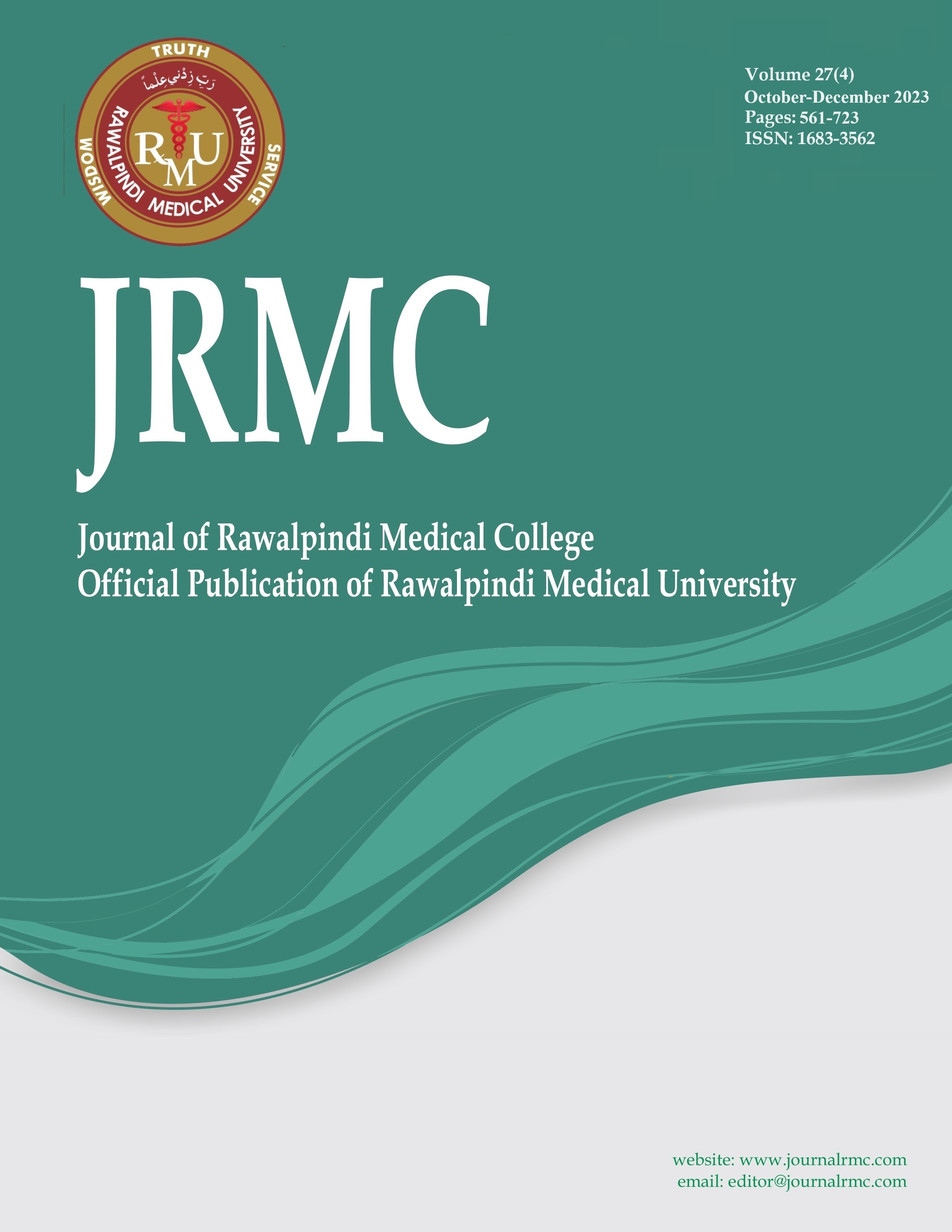Abstract
Objective: The study aimed to explore the potential benefits of vitamin D supplementation in improving acne severity.
Methods: This pilot study was carried out at HIT Hospital, Taxila. The study included nine female patients aged between 12 and 30 years, with acne vulgaris and having deficient serum 25-hydroxyvitamin D3 (25(OH)D) levels (<30 nmol/L). Exclusion criteria included the use of topical or oral treatments for acne, including retinoids, as well as those with a history of multivitamin or systemic steroid intake, and patients with any chronic disease. Global Acne Grading (GAG) score was used to assess the severity of acne vulgaris. Patients received a daily dosage of 1000 IU of vitamin D drops per day for 2 months so that vitamin D deficiency is corrected. After 2 months, the GAG score was re-calculated and documented. Data analysis was performed using SPSS version 28.
Results: The mean age of the study participants was 18.33 years (SD= 3.3 Years). A statistically insignificant association (p=0.49) and weak positive correlation (r= 0.17, p=0.65) were observed between Vit D levels and acne Status and GAG-1 score on applying chi-square test and Pearson correlation respectively. A paired-sample t-test showed a significant difference in the GAG-1 Score (Mean=25.44, SD=7.6) and GAG-2 Score (M=15.1, SD=4.5) after Vit D supplementation. t (5.3), (p= 0.001).
Conclusion: The results suggest that correcting vitamin D deficiency through supplementation resulted in a significant improvement in acne severity.
Keywords: Acne vulgaris, Vitamin D, GAG score
References
Vanchinathan V, Lim HW. A dermatologist's perspective on vitamin D. InMayo Clinic Proceedings. Elsevier. 2012 Apr 1;87(4): 372-380. DOI:10.1016/j.mayocp.2011.12.010
Hawker NP, Pennypacker SD, Chang SM, Bikle DD. Regulation of human epidermal keratinocyte differentiation by the vitamin D receptor and its coactivators DRIP205, SRC2, and SRC3. Journal of investigative dermatology. 2007 Apr 1;127(4):874-80.DOI:10.1038/sj.jid.5700624
Veleva BI, Caljouw MA, Muurman A, van der Steen JT, Chel VG, Numans ME, Poortvliet RK. The effect of ultraviolet irradiation compared to oral vitamin D supplementation on blood pressure of nursing home residents with dementia. BMC geriatrics. 2021 Dec; 21:1-9. DOI:10.1186/s12877-021-02538-7.
Zouboulis CC, Seltmann H, Abdel-Naser BM, Hossini AM, Menon GK, Kubba R. Effects of extracellular calcium and 1, 25 dihydroxyvitamin D3 on sebaceous gland cells in vitro and in vivo. Acta Dermato-Venereologica. 2017;97(3):313-20. DOI:10.2340/00015555-2525.
Elsholz F, Harteneck C, Muller W, Friedland K. Calcium—A central regulator of keratinocyte differentiation in health and disease. European Journal of Dermatology. 2014 Dec; 24:650-61.DOI:10.1684/ejd.2014.2452.
Kimball SM, Holick MF. Official recommendations for vitamin D through the life stages in developed countries. European journal of clinical nutrition. 2020 Nov;74(11):1514-8.DOI: 10.1038/s41430-020-00706-3
Rueda LJ, Porras A, Rico A. Prevalence of adult female acne in Colombia: A population-based study. International Journal of Women's Dermatology. 2021 Dec 1;7(5):727-30. DOI:10.1016/j.ijwd.2021.06.003
Bagatin E, Freitas TH, Rivitti-Machado MC, Ribeiro BM, Nunes S, Rocha MA. Adult female acne: a guide to clinical practice. Anais brasileiros de dermatologia. 2019 Jan; 94:62-75.DOI:10.1590/abd1806-4841.20198203.
Agak GW, Qin M, Nobe J, Kim MH, Krutzik SR, Tristan GR, Elashoff D, Garbán HJ, Kim J. Propionibacterium acnes induces an IL-17 response in acne vulgaris that is regulated by vitamin A and vitamin D. Journal of Investigative Dermatology. 2014 Feb 1;134(2):366-73.DOI: 10.1038/jid.2013.334
Alsulaimani H, Kokandi A, Khawandanh S, Hamad R. Severity of acne vulgaris: comparison of two assessment methods. Clinical, Cosmetic and Investigational Dermatology. 2020 Sep 28:711-6. https://doi.org/10.2147/ccid.s266320
Ross AC, Taylor CL, Yaktine AL, Del Valle HB. Committee to review dietary reference intakes for vitamin D and calcium. Food and Nutrition Board. 2011 Jun 22. DOI:10.17226/13050
Iqbal T, Asim SA, Bhatti S, Sajid M, Mirza R, Huma Z. Association of Vitamin D with Moderate to Severe Acne Vulgaris. Journal of the College of Physicians and Surgeons--Pakistan: JCPSP. 2023 May 1;33(5):527-30.DOI:10.29271/jcpsp.2023.05.527
El-Tahlawi SM, Mohamed NE, Mohamed SR, Abd El Nasser L. Serum level of vitamin D &Beta-2-defensin in patients with acne vulgaris. Fayoum University Medical Journal. 2020 Sep 1;7(1):134-46.DOI:10.21608/fumj.2020.174377
Goodarzi A, Behrangi E, Ghassemi M, Mehran G, Teymoori N, Ghahremani AP, Biglari Abhari M. Comparison of serum levels of calcium, vitamin-D, phosphorous and C-reactive protein in acne patients versus healthy subjects. Iranian Journal of Dermatology. 2020 Apr 1;23(1):16-20. DOI:10.22034/ijd.2020.108064
Puspita F, Simanungkalit R, Yosi A. Correlation between serum 25-hydroxyvitamin D level with acne vulgaris severity. Int J Sci Res Publ. 2020;10(1):9750.
Akta S, Karabay E, Aksu Çerman A. Serum Levels of 25-Hydroxyvitamin-D and C-Reactive Protein in Acne Vulgaris Patients. Turkiye Klinikleri Journal of Dermatology. 2019 Jan 1;29(1).DOI:10.5336/dermato.2018-63846
Toossi P, Azizian Z, Yavari H, Fakhim TH, Amini SH, Enamzade R. Serum 25-hydroxy vitamin D levels in patients with acne vulgaris and its association with disease severity. Clinical Cases in Mineral and Bone Metabolism. 2015 Sep;12(3):238.DOI:10.11138/ccmbm/2015.12.3.238
Kemeriz F, Tuncer SÇ, Acar EM, Tuğrul B. Evaluation of 25‐hydroxy vitamin D levels and disease severity in patients with acne vulgaris. Dermatologic Therapy. 2020 May;33(3):e13393.DOI:10.1111/dth.13393.

This work is licensed under a Creative Commons Attribution-ShareAlike 4.0 International License.
Copyright (c) 2023 Aqsa Naheed, Aashi Mughal, Tehzeeb Zehra, Rahila Aamir, Samina Fida, Taha Naveed





